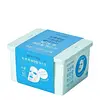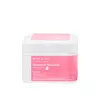What's inside
What's inside
 Key Ingredients
Key Ingredients

 Benefits
Benefits

 Concerns
Concerns

 Ingredients Side-by-side
Ingredients Side-by-side

Water
Skin ConditioningGlycerin
HumectantMethylpropanediol
SolventButylene Glycol
Humectant1,2-Hexanediol
Skin ConditioningSodium Hyaluronate
HumectantSodium Acetylated Hyaluronate
HumectantHydrolyzed Hyaluronic Acid
HumectantLactobacillus/Soybean Ferment Extract
Skin ConditioningLactobacillus/Rice Ferment Filtrate
Skin ConditioningLactobacillus
Skin ConditioningSaccharomyces/Coix Lacryma-Jobi Ma-Yuen Seed Ferment Filtrate
Skin ConditioningSaccharomyces/Potato Extract Ferment Filtrate
HumectantGlycine
BufferingSerine
MaskingGlutamic Acid
HumectantAspartic Acid
MaskingLeucine
Skin ConditioningAlanine
MaskingLysine
Skin ConditioningTyrosine
MaskingPhenylalanine
MaskingThreonine
Proline
Skin ConditioningValine
MaskingIsoleucine
Skin ConditioningHistidine
HumectantMethionine
Skin ConditioningCysteine
AntioxidantTremella Fuciformis Polysaccharide
Emulsion StabilisingPyrus Communis Fruit Extract
Skin ConditioningRosa Damascena Flower Water
MaskingCucumis Melo Fruit Extract
Skin ConditioningVetiveria Zizanoides Root Oil
MaskingHedera Helix Leaf/Stem Extract
AntimicrobialOlea Europaea Fruit Oil
MaskingButyrospermum Parkii Butter
Skin ConditioningHydrogenated Lecithin
EmulsifyingSqualane
EmollientCholesterol
EmollientCeramide NP
Skin ConditioningPhytosphingosine
Skin ConditioningAcetyl Glucosamine
Skin ConditioningSodium Polygamma-Glutamate
Emulsion StabilisingMusa Sapientum Fruit Extract
Skin ConditioningCaprylic/Capric Triglyceride
MaskingPropanediol
SolventFructan
Skin ConditioningAllantoin
Skin ConditioningTrehalose
HumectantArginine
MaskingDextrin
AbsorbentHydroxypropyl Methylcellulose
Emulsion StabilisingCI 77220
Cosmetic ColorantGlycolic Acid
BufferingHydroxyacetophenone
AntioxidantTocopheryl Acetate
AntioxidantCarbomer
Emulsion StabilisingXanthan Gum
EmulsifyingPolyglyceryl-10 Laurate
Skin ConditioningCitric Acid
BufferingSodium Citrate
BufferingDisodium EDTA
Water, Glycerin, Methylpropanediol, Butylene Glycol, 1,2-Hexanediol, Sodium Hyaluronate, Sodium Acetylated Hyaluronate, Hydrolyzed Hyaluronic Acid, Lactobacillus/Soybean Ferment Extract, Lactobacillus/Rice Ferment Filtrate, Lactobacillus, Saccharomyces/Coix Lacryma-Jobi Ma-Yuen Seed Ferment Filtrate, Saccharomyces/Potato Extract Ferment Filtrate, Glycine, Serine, Glutamic Acid, Aspartic Acid, Leucine, Alanine, Lysine, Tyrosine, Phenylalanine, Threonine, Proline, Valine, Isoleucine, Histidine, Methionine, Cysteine, Tremella Fuciformis Polysaccharide, Pyrus Communis Fruit Extract, Rosa Damascena Flower Water, Cucumis Melo Fruit Extract, Vetiveria Zizanoides Root Oil, Hedera Helix Leaf/Stem Extract, Olea Europaea Fruit Oil, Butyrospermum Parkii Butter, Hydrogenated Lecithin, Squalane, Cholesterol, Ceramide NP, Phytosphingosine, Acetyl Glucosamine, Sodium Polygamma-Glutamate, Musa Sapientum Fruit Extract, Caprylic/Capric Triglyceride, Propanediol, Fructan, Allantoin, Trehalose, Arginine, Dextrin, Hydroxypropyl Methylcellulose, CI 77220, Glycolic Acid, Hydroxyacetophenone, Tocopheryl Acetate, Carbomer, Xanthan Gum, Polyglyceryl-10 Laurate, Citric Acid, Sodium Citrate, Disodium EDTA
Water
Skin ConditioningGlycerin
HumectantDipropylene Glycol
HumectantHydroxyacetophenone
AntioxidantPolyglyceryl-10 Laurate
Skin ConditioningHydroxyethyl Urea
HumectantPolyglyceryl-4 Laurate
EmulsifyingPanthenol
Skin ConditioningArginine
MaskingCarbomer
Emulsion StabilisingCaprylyl/Capryl Glucoside
CleansingParfum
MaskingAllantoin
Skin ConditioningButylene Glycol
Humectant1,2-Hexanediol
Skin ConditioningCaprylyl Glycol
EmollientDisodium EDTA
Hydroxyethylcellulose
Emulsion StabilisingSodium Hyaluronate
HumectantPentylene Glycol
Skin ConditioningSodium Hyaluronate Crosspolymer
HumectantHydrolyzed Hyaluronic Acid
HumectantHyaluronic Acid
HumectantEthylhexylglycerin
Skin ConditioningHydrolyzed Sodium Hyaluronate
Skin ConditioningWater, Glycerin, Dipropylene Glycol, Hydroxyacetophenone, Polyglyceryl-10 Laurate, Hydroxyethyl Urea, Polyglyceryl-4 Laurate, Panthenol, Arginine, Carbomer, Caprylyl/Capryl Glucoside, Parfum, Allantoin, Butylene Glycol, 1,2-Hexanediol, Caprylyl Glycol, Disodium EDTA, Hydroxyethylcellulose, Sodium Hyaluronate, Pentylene Glycol, Sodium Hyaluronate Crosspolymer, Hydrolyzed Hyaluronic Acid, Hyaluronic Acid, Ethylhexylglycerin, Hydrolyzed Sodium Hyaluronate
 Reviews
Reviews

Ingredients Explained
These ingredients are found in both products.
Ingredients higher up in an ingredient list are typically present in a larger amount.
1,2-Hexanediol is a synthetic liquid and another multi-functional powerhouse.
It is a:
- Humectant, drawing moisture into the skin
- Emollient, helping to soften skin
- Solvent, dispersing and stabilizing formulas
- Preservative booster, enhancing the antimicrobial activity of other preservatives
Allantoin is a soothing ingredient known for its protective and moisturizingg properties. Because of this, it is often added to products with strong active ingredients.
Studies show higher concentrations of this ingredient can promote wound healing.
Though it can be derived from the comfrey plant, allantoin is produced synthetically for cosmetic products to ensure purity.
Learn more about AllantoinArginine is an amino acid that is important for human development. Your body uses is it to produce hair keratin and skin collagen.
As a cosmetic ingredient, Arginine has antioxidant properties and can also help repair damaged skin. This ingredient is derived either synthetically or from animals.
Arginine isn't fungal acne safe when used in the presence of other lipids (fats, fatty acids, oils, esters, etc). Oils and fats occur naturally within the skin, so take caution when using Arginine if you're prone to fungal acne.
Learn more about ArginineButylene Glycol (or BG) is used within cosmetic products for a few different reasons:
Overall, Butylene Glycol is a safe and well-rounded ingredient that works well with other ingredients.
Though this ingredient works well with most skin types, some people with sensitive skin may experience a reaction such as allergic rashes, closed comedones, or itchiness.
Learn more about Butylene GlycolCarbomer is a polymer of acrylic acid. Its main role is to create a gel consistency.
A high amount of carbomer can cause pilling or balling up of products. Don't worry, most products contain 1% or less of carbomer.
Disodium EDTA plays a role in making products more stable by aiding other preservatives.
It is a chelating agent, meaning it neutralizes metal ions that may be found in a product.
Disodium EDTA is a salt of edetic acid and is found to be safe in cosmetic ingredients.
Learn more about Disodium EDTAGlycerin is already naturally found in your skin. It helps moisturize and protect your skin.
A study from 2016 found glycerin to be more effective as a humectant than AHAs and hyaluronic acid.
As a humectant, it helps the skin stay hydrated by pulling moisture to your skin. The low molecular weight of glycerin allows it to pull moisture into the deeper layers of your skin.
Hydrated skin improves your skin barrier; Your skin barrier helps protect against irritants and bacteria.
Glycerin has also been found to have antimicrobial and antiviral properties. Due to these properties, glycerin is often used in wound and burn treatments.
In cosmetics, glycerin is usually derived from plants such as soybean or palm. However, it can also be sourced from animals, such as tallow or animal fat.
This ingredient is organic, colorless, odorless, and non-toxic.
Glycerin is the name for this ingredient in American English. British English uses Glycerol/Glycerine.
Learn more about GlycerinHydrolyzed Hyaluronic Acid is a form of hyaluronic acid. It is created by the hydrolysis of hyaluronic acid with a high molecular weight. Once created, Hydrolyzed Hyaluronic Acid has a low molecular weight.
Low molecular weight HA has been shown to hydrate and increase elasticity of the skin. Increasing elasticity is also associated with reduction of wrinkle depth.
One study found topical low molecular weight hyaluronic acid may be considered for the treatment of rosacea in the adult population. However, we always recommend speaking with a professional about your skin concerns.
Hyaluronic acids are a humectant. This means they draw moisture from the air. Hyaluronic acids help moisturize, soothe, and protect the skin.
Read more about other common forms of hyaluronic acid:
Learn more about Hydrolyzed Hyaluronic AcidHydroxyacetophenone is antioxidant with skin conditioning and soothing properties. It also boosts the efficiency of preservatives.
This ingredient is not irritating or sensitizing.
Polyglyceryl-10 Laurate is an ester of lauric acid and Polyglycerin-10.
Polyglyceryl-10 Laurate is a cleansing agent and emulsifier. It helps gather dirt, oil, and other pollutants to be rinsed away. As an emulsifier, it helps prevent ingredients from separating, such as oil and water.
Polyglyceryl-10 Laurate may not be fungal acne safe.
Learn more about Polyglyceryl-10 LaurateSodium Hyaluronate is hyaluronic acid's salt form. It is commonly derived from the sodium salt of hyaluronic acid.
Like hyaluronic acid, it is great at holding water and acts as a humectant. This makes it a great skin hydrating ingredient.
Sodium Hyaluronate is naturally occurring in our bodies and is mostly found in eye fluid and joints.
These are some other common types of Hyaluronic Acid:
Learn more about Sodium HyaluronateWater. It's the most common cosmetic ingredient of all. You'll usually see it at the top of ingredient lists, meaning that it makes up the largest part of the product.
So why is it so popular? Water most often acts as a solvent - this means that it helps dissolve other ingredients into the formulation.
You'll also recognize water as that liquid we all need to stay alive. If you see this, drink a glass of water. Stay hydrated!
Learn more about Water